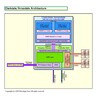Intel Core i3-330UM vs Intel Core i3-330M
Intel Core i3-330UM
► remove from comparisonThe Intel Core i3-330UM is a Ultra Low Voltage dual-core processor for small and light laptops. It is clocked with 1.2 GHz and does not feature Turbo Boost to overclock the CPU cores. Another feature missing compared to the i5 and i7 lineup is the AES function block. Each core is based on the Nehalem (Westmere) micro-architecture. Hyperthreading enables the Dual Core CPU to handle 4 threads at once (for a better usage of the pipeline).
A feature of the new Core i3-330UM is the integrated graphics card (called Intel HD Graphics) and memory controller. Both are on a separate die that is still manufactured in 45nm whereas the CPU die is already manufactured in the new 32nm process. The also called GMA HD is able to use Turbo Boost to overclock from 133 to 500 MHz.
Due to the integrated memory controller and HyperThreading, the Core i3-330UM is faster than a similar clocked Core 2 Duo (1.2 GHz) in all (us known) applications and benchmarks. Therefore it should beat the 1.3 GHz Pentium SU7300. Still the gaming performance will suffer from the low clock speed.
The power consumption of 18 Watt TDP (max.) counts for the whole package and therefore it is clearly better than the 17 Watt TDP of the Core 2 Duo SL-series (CPU alone).
Intel Core i3-330M
► remove from comparison
The Intel Core i3-330M is a lower-middle class dual core CPU for laptops and clocks with 2.16 GHz. The difference to the Core i5-430M is the lacking Turbo Boost overclocking and the slower core speed. Each core is based on the Nehalem (Westmere) micro-architecture. Hyperthreading enables the Dual Core CPU to handle 4 threads at once (for a better usage of the pipeline).
A feature of the new Core i3-330M is the integrated graphics card called Intel HD Graphics or GMA HD and a DDR3 1066 MHz memory controller. Both are on a separate die that is still manufactured in 45nm whereas the CPU die is already manufactured in the new 32nm process.
The performance in synthetic benchmarks is mostly on par with a 2.4 GHz Core 2 Duo P8600 (due to the improved hyperthreading). The speed should be at least as fast as a 2.2 GHz Core 2 Duo and therefore the i3-330M positions itself in the middle class (lower middle class regarding Core i CPUs). It should handle all applications well, but some demanding games could profit from a faster CPU.
The 32nm cpu cores of the Westmere generation can also process some new instructions to accelerate AES encryptions. In the i3-330M Intel has deactivated these new AES functions.
The integrated Intel Graphics Media Accelerator HD (GMA HD) graphics card is known to be clocked up to 500 MHz and should be clearly faster than the old GMA 4500MHD. The Core i5 and i7 models should still be a bit faster because of the higher max. clock speed of the GPU. A GeForce 9400M (ION) should still be a faster (especially as Nvidia and ATI cards have a better driver support than Intel up to now). According to rumors, the GMA core will also use the Turbo Mode regulate the clock speed.
The power consumption of 35 Watt TDP (max.) counts for the whole package and therefore it is clearly better than the 35 Watt TDP of the Core 2 Duo T-series (CPU alone).
| Model | Intel Core i3-330UM | Intel Core i3-330M | ||||||||||||||||||||||||||||||||||||||||||||||||||||||||
| Series | Intel Core i3 | Intel Core i3 | ||||||||||||||||||||||||||||||||||||||||||||||||||||||||
| Codename | Arrandale | Arrandale | ||||||||||||||||||||||||||||||||||||||||||||||||||||||||
| Series: Core i3 Arrandale |
|
| ||||||||||||||||||||||||||||||||||||||||||||||||||||||||
| Clock | 1200 MHz | 2130 MHz | ||||||||||||||||||||||||||||||||||||||||||||||||||||||||
| FSB | 2500 | 2500 | ||||||||||||||||||||||||||||||||||||||||||||||||||||||||
| L2 Cache | 512 KB | 512 KB | ||||||||||||||||||||||||||||||||||||||||||||||||||||||||
| L3 Cache | 3 MB | 3 MB | ||||||||||||||||||||||||||||||||||||||||||||||||||||||||
| Cores / Threads | 2 / 4 | 2 / 4 | ||||||||||||||||||||||||||||||||||||||||||||||||||||||||
| TDP | 18 Watt | 35 Watt | ||||||||||||||||||||||||||||||||||||||||||||||||||||||||
| Transistors | 382+177 Million | 177+382 Million | ||||||||||||||||||||||||||||||||||||||||||||||||||||||||
| 32 nm | 32 nm, 0.775 - 1 V (low frequency mode) 0.8 - 1.4 V | |||||||||||||||||||||||||||||||||||||||||||||||||||||||||
| Die Size | 81+114 mm2 | 81+114 mm2 | ||||||||||||||||||||||||||||||||||||||||||||||||||||||||
| max. Temp. | 105 °C | 90 (rPGA) -100 (BGA) °C | ||||||||||||||||||||||||||||||||||||||||||||||||||||||||
| Socket | BGA1288 | BGA1288, PGA988 | ||||||||||||||||||||||||||||||||||||||||||||||||||||||||
| Features | Intel HD Graphics 166-500MHz, DDR3-800 Memory Controller, Hyper-Threading, Virtualization Technology VT-x, Intel 64, Idle States, Enhanced Speedstep, Thermal Monitoring, Fast Memory Access, Flex Memory Access, Execute Disable Bit | Hyper Threading, Enhanced Speedstep, integrated GMA HD 500MHz, integrated DDR3 1066 memory controller | ||||||||||||||||||||||||||||||||||||||||||||||||||||||||
| Architecture | x86 | x86 | ||||||||||||||||||||||||||||||||||||||||||||||||||||||||
| Announced | ||||||||||||||||||||||||||||||||||||||||||||||||||||||||||
| Manufacturer | ark.intel.com | ark.intel.com |


 Deutsch
Deutsch English
English Español
Español Français
Français Italiano
Italiano Nederlands
Nederlands Polski
Polski Português
Português Русский
Русский Türkçe
Türkçe Svenska
Svenska Chinese
Chinese Magyar
Magyar
